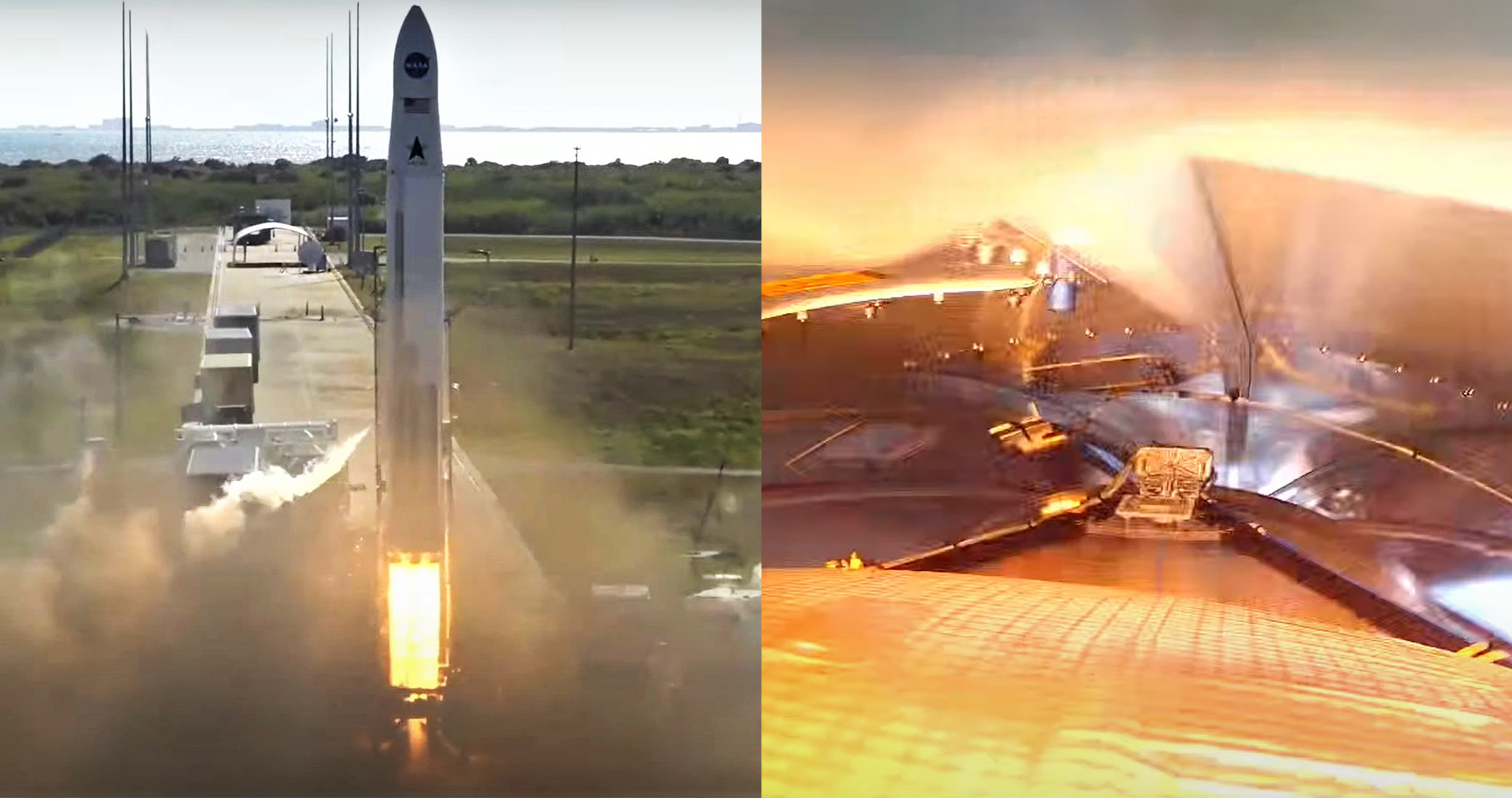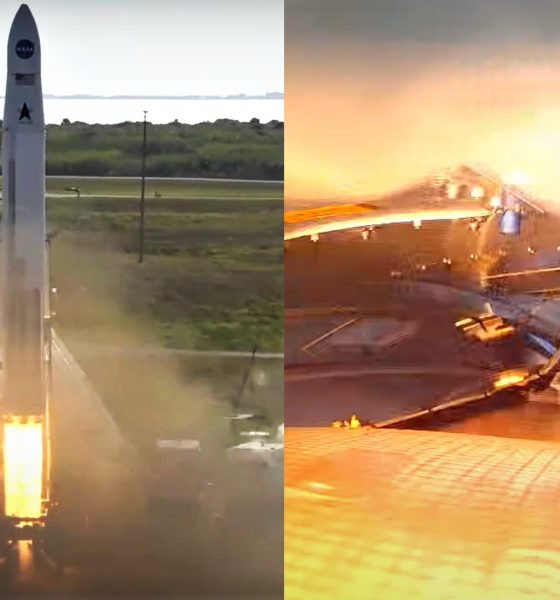

News
Astra ‘Rocket 3’ nosecone dooms first Florida launch attempt
On Thursday, February 10th, Astra Space’s Rocket 3.3 launch vehicle took off from Cape Canaveral Space Force Station (CCSFS) Launch Complex 46 (LC-46).
Unfortunately, while liftoff and booster ascent appeared to be more or less perfect, Rocket 3’s payload fairing failed to separate, triggering a series of events that caused its upper stage to enter an uncontrolled and unrecoverable spin after burning for just a few seconds. Astra was unable to salvage the spinning rocket, resulting in a mission failure well short of orbit.
“Unfortunately we heard that an issue has been experienced during flight that prevented the delivery of our customer payloads to orbit today. We are deeply sorry to our customers NASA, University of Alabama, the University of Mexico and the University of California Berkeley,” said Astra Space Director of Product Management Carolina Grossman. “More information will be provided as we complete the data review.”
Today’s launch comes after two previous aborted launch attempts. The first attempt on February 5th was delayed due to a CCSFS radar system malfunction. The second launch delay came on February 7th, after the rocket aborted briefly after ignition because of a minor telemetry issue.
The Mission
NASA’s first mission under the agency’s Venture Class Launch Services (VCLS) Demonstration 2 contract hoped to launch four CubeSats to space as early as February 5th, 2022. The satellites, which made up the agency’s 41st Educational Launch of Nano-satellites (ELaNa) mission, were the first VCLS payloads launched – albeit unsuccessfully – from Cape Canaveral’s LC-46 pad, which last supported NASA’s Orion spacecraft Ascent Abort 2 (AA-2) test flight in July 2019.
The satellites onboard the flight were developed by three universities and one NASA center:
- BAMA 1 (University of Alabama, Tusscolusa)
- INCA (New Mexico State University, Las Cruces)
- QubeSat (University of California, Berkeley)
- R5-S1 (NASA’s Johnson Space Center, Houston)
The ELaNa 41 mission CubeSats were selected through NASA’s CubeSat Launch Initiative (CSLI) and were assigned to the mission by NASA’s Launch Services Program based at Kennedy. CSLI provides launch opportunities for small satellite payloads built by universities, high schools, NASA Centers, and non-profit organizations.
About Astra
Founded in 2016, Astra Space is an American launch vehicle company based in Alameda, California. Astra’s official vision “is to Improve Life on Earth from Space by creating a healthier and more connected planet.” The company hopes to secure a large portion of the small satellite launch market, stating that it “offers the lowest cost-per-launch dedicated orbital launch service of any operational launch provider in the world.”
As of November 2021, Astra charges around $2.5-3.5M for a dedicated Rocket 3 launch, which can deliver up to 150 kg (330 lb) to low Earth orbit (LEO). In comparison, for a dedicated Electron launch, Rocket Lab charges about $7.5M for 300 kg (660 lb) to LEO. For customers willing to accept a one-size-fits-all rideshare solution, SpaceX charges $1M for 200 kg (440 lb) to LEO or higher sun-synchronous orbits (SSOs).
While the aerospace company is based out of California, its frequent orbital and suborbital test flights have all been conducted at the Pacific Spaceport Complex in Kodiak, Alaska. Prior test flights used Rocket 1, Rocket 2, and Rocket 3 prototypes as Astra refined its design and embraced a hardware-rich development style that didn’t shy away from failure.
Rocket 3.3 reached orbit for the first time – carrying an instrumented boilerplate payload for the United States Space Force – on November 21st, 2021. Less than two months later, Rocket 3.3 (serial number LV08) attempted to carry several NASA-sponsored cubesats into orbit on February 10th, 2022 – also the rocket’s first East Coast launch. Like Rocket 3.3’s predecessors, the two-stage vehicle was fueled with liquid oxygen (LOx) and refined kerosene (RP-1). Powered by five Delphin engines, the first stage produces up to ~145 kilonewtons (32,500 lbf) of thrust at liftoff. The second stage is powered by one pressure-fed Aether engine that delivers about 3.3 kN (740 lbf) of thrust in the vacuum of space.
The unsuccessful launch attempt occurred just three months after Astra applied for their Federal Aviation Administration (FAA) launch license and less than one day after receiving that license.

News
Elon Musk’s Grokipedia surges to 5.6M articles, almost 79% of English Wikipedia
The explosive growth marks a major milestone for the AI-powered online encyclopedia, which was launched by Elon Musk’s xAI just months ago.

Elon Musk’s Grokipedia has grown to an impressive 5,615,201 articles as of today, closing in on 79% of the English Wikipedia’s current total of 7,119,376 articles.
The explosive growth marks a major milestone for the AI-powered online encyclopedia, which was launched by Elon Musk’s xAI just months ago. Needless to say, it would only be a matter of time before Grokipedia exceeds English Wikipedia in sheer volume.
Grokipedia’s rapid growth
xAI’s vision for Grokipedia emphasizes neutrality, while Grok’s reasoning capabilities allow for fast drafting and fact-checking. When Elon Musk announced the initiative in late September 2025, he noted that Grokipedia would be an improvement to Wikipedia because it would be designed to avoid bias.
At the time, Musk noted that Grokipedia “is a necessary step towards the xAI goal of understanding the Universe.”
Grokipedia was launched in late October, and while xAI was careful to list it only as Version 0.1 at the time, the online encyclopedia immediately earned praise. Wikipedia co-founder Larry Sanger highlighted the project’s innovative approach, noting how it leverages AI to fill knowledge gaps and enable rapid updates. Netizens also observed how Grokipedia tends to present articles in a more objective manner compared to Wikipedia, which is edited by humans.
Elon Musk’s ambitious plans
With 5,615,201 total articles, Grokipedia has now grown to almost 79% of English Wikipedia’s article base. This is incredibly quick, though Grokipedia remains text-only for now. xAI, for its part, has now updated the online encyclopedia’s iteration to v0.2.
Elon Musk has shared bold ideas for Grokipedia, including sending a record of the entire knowledge base to space as part of xAI’s mission to preserve and expand human understanding. At some point, Musk stated that Grokipedia will be renamed to Encyclopedia Galactica, and it will be sent to the cosmos.
“When Grokipedia is good enough (long way to go), we will change the name to Encyclopedia Galactica. It will be an open source distillation of all knowledge, including audio, images and video. Join xAI to help build the sci-fi version of the Library of Alexandria!” Musk wrote, adding in a later post that “Copies will be etched in stone and sent to the Moon, Mars and beyond. This time, it will not be lost.”
News
Tesla Model 3 becomes Netherlands’ best-selling used EV in 2025
More than one in ten second-hand electric cars sold in the country last year was a Tesla Model 3.

The Tesla Model 3 became the most popular used electric car in the Netherlands in 2025, cementing its dominance well beyond the country’s new-car market.
After years at the top of Dutch EV sales charts, the Model 3 now leads the country’s second-hand EV market by a wide margin, as record used-car purchases pushed electric vehicles further into the mainstream.
Model 3 takes a commanding lead
The Netherlands recorded more than 2.1 million used car sales last year, the highest level on record. Of those, roughly 4.8%, or about 102,000 vehicles, were electric. Within that growing segment, the Tesla Model 3 stood far ahead of its competitors.
In 2025 alone, 11,338 used Model 3s changed hands, giving the car an 11.1% share of the country’s entire used EV market. That means more than one in ten second-hand electric cars sold in the country last year was a Tesla Model 3, Auto Week Netherlands reported. The scale of its lead is striking: the gap between the Model 3 and the second-place finisher, the Volkswagen ID3, is more than 6,700 vehicles.
Rivals trail as residual values shape rankings
The Volkswagen ID.3 ranked a distant second, with 4,595 used units sold and a 4.5% market share. Close behind was the Audi e-tron, which placed third with 4,236 registrations. As noted by Auto Week Netherlands, relatively low residual values likely boosted the e-tron’s appeal in the used market, despite its higher original price.
Other strong performers included the Kia Niro, the Tesla Model Y, and the Hyundai Kona, highlighting continued demand for compact and midsize electric vehicles with proven range and reliability. No other model, however, came close to matching the Model 3’s scale or market presence.
News
Tesla Model Y Standard Long Range RWD launches in Europe
The update was announced by Tesla Europe & Middle East in a post on its official social media account on X.

Tesla has expanded the Model Y lineup in Europe with the introduction of the Standard Long Range RWD variant, which offers an impressive 657 km of WLTP range.
The update was announced by Tesla Europe & Middle East in a post on its official social media account on X.
Model Y Standard Long Range RWD Details
Tesla Europe & Middle East highlighted some of the Model Y Standard Long Range RWD’s most notable specs, from its 657 km of WLTP range to its 2,118 liters of cargo volume. More importantly, Tesla also noted that the newly released variant only consumes 12.7 kWh per 100 km, making it the most efficient Model Y to date.
The Model Y Standard provides a lower entry point for consumers who wish to enter the Tesla ecosystem at the lowest possible price. While the Model 3 Standard is still more affordable, some consumers might prefer the Model Y Standard due to its larger size and crossover form factor. The fact that the Model Y Standard is equipped with Tesla’s AI4 computer also makes it ready for FSD’s eventual rollout to the region.
Top Gear’s Model Y Standard review
Top Gear‘s recent review of the Tesla Model Y Standard highlighted some of the vehicle’s most notable features, such as its impressive real-world range, stellar infotainment system, and spacious interior. As per the publication, the Model Y Standard still retains a lot of what makes Tesla’s vehicles well-rounded, even if it’s been equipped with a simplified interior.
Top Gear compared the Model Y Standard to its rivals in the same segment. “The introduction of the Standard trim brings the Model Y in line with the entry price of most of its closest competition. In fact, it’s actually cheaper than a Peugeot e-3008 and costs £5k less than an entry-level Audi Q4 e-tron. It also makes the Ford Mustang Mach-E look a little short with its higher entry price and worse range,” the publication wrote.








